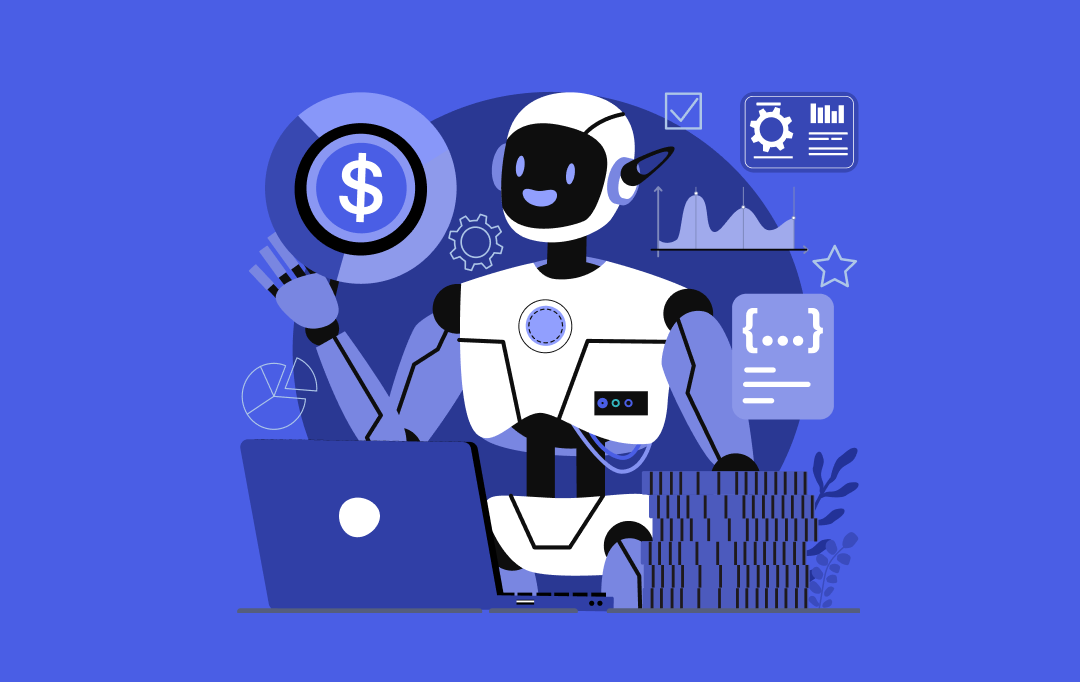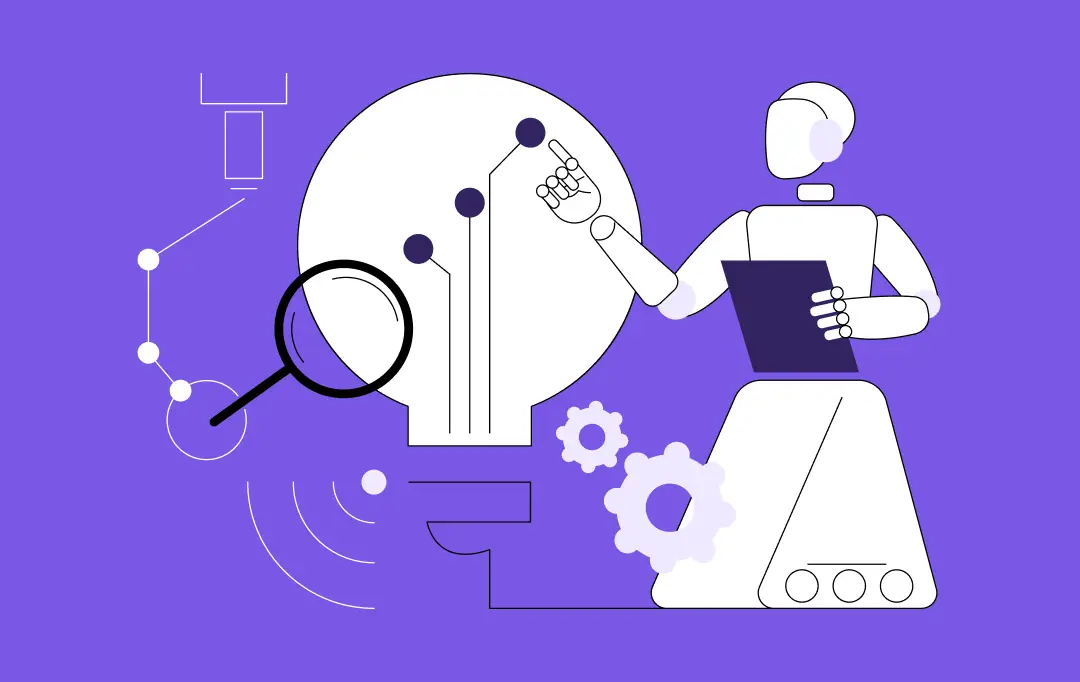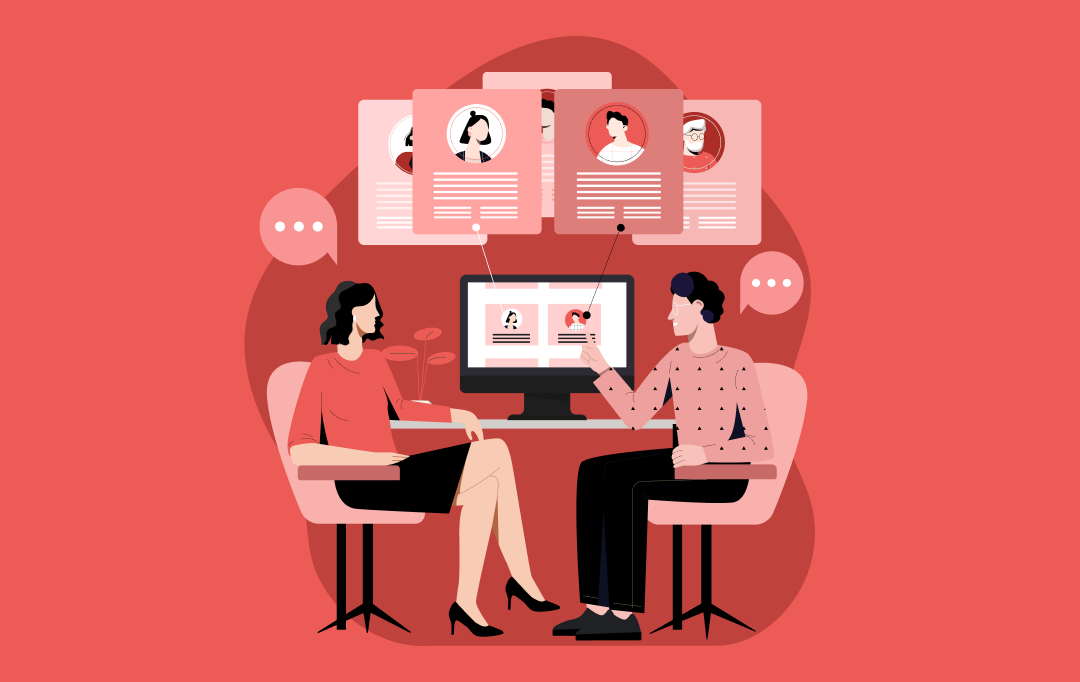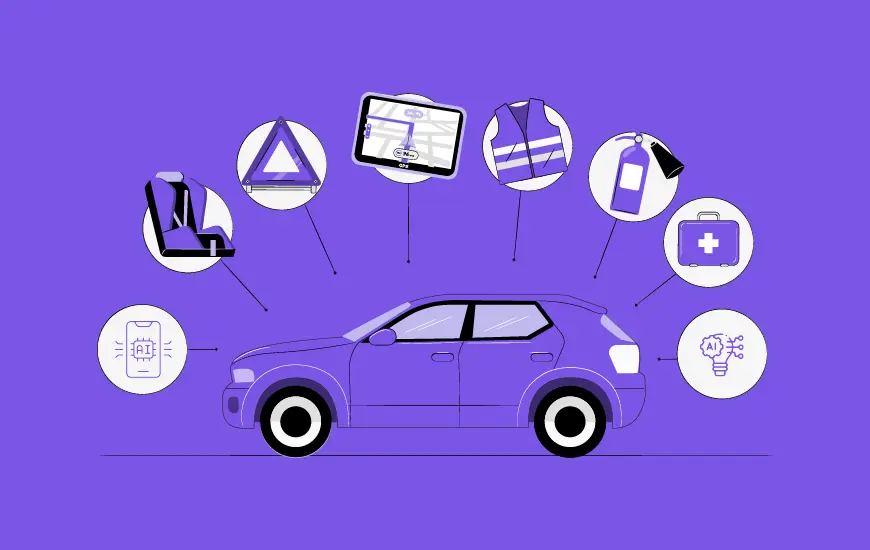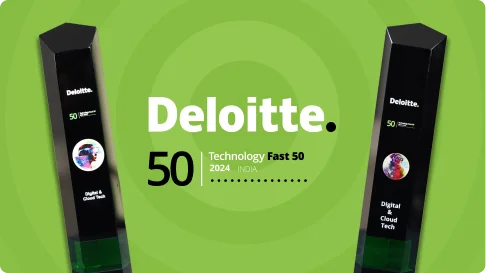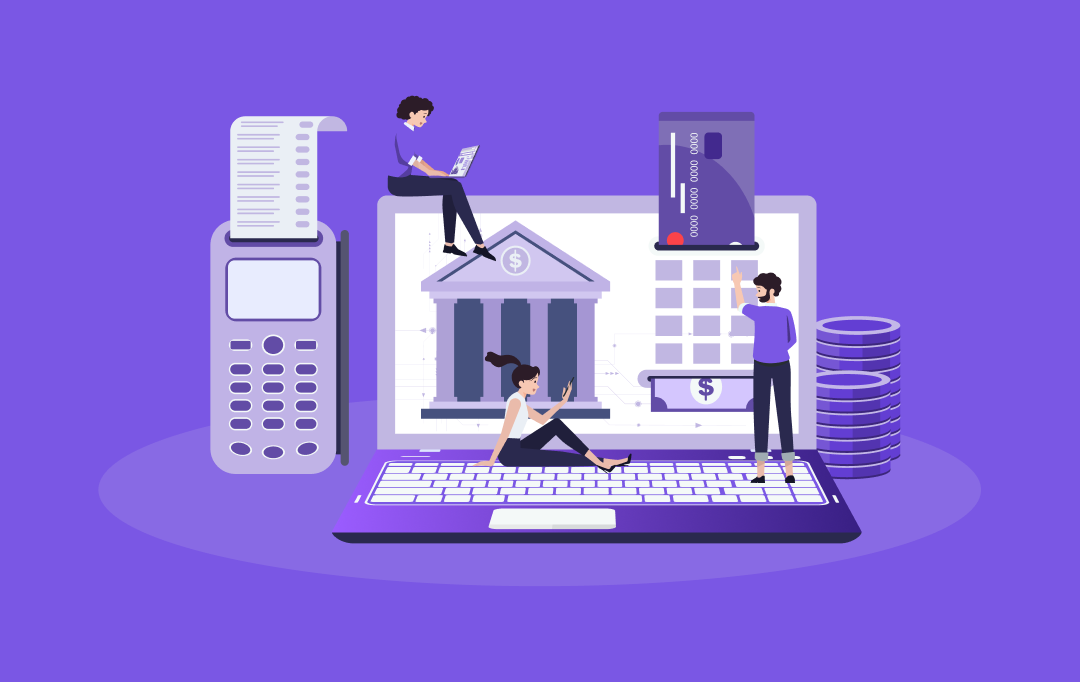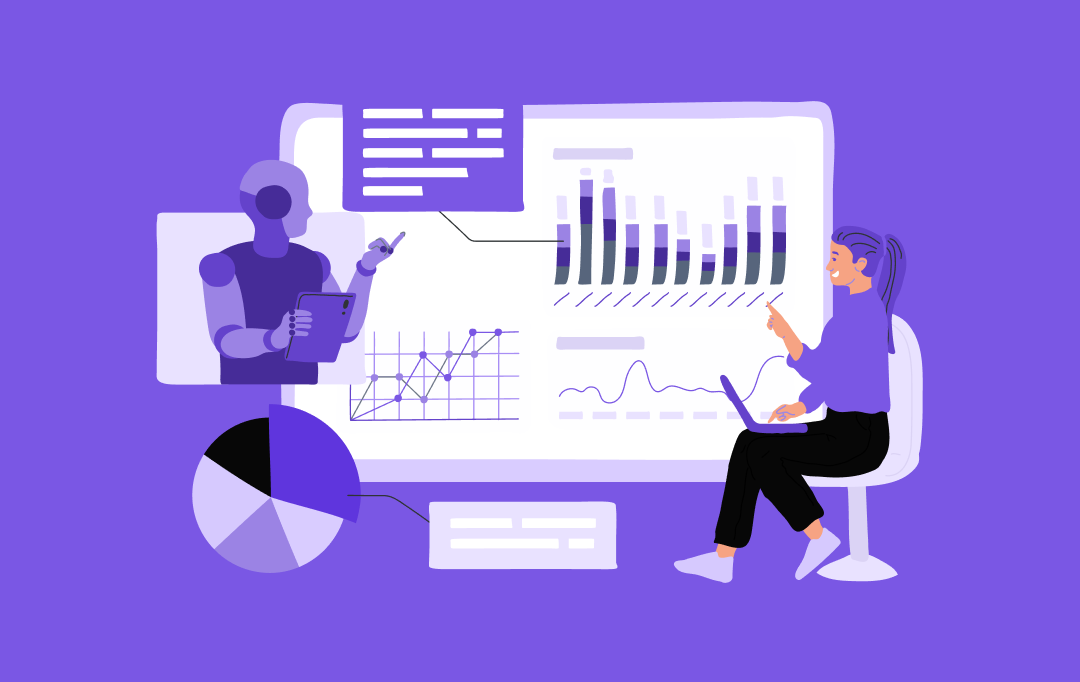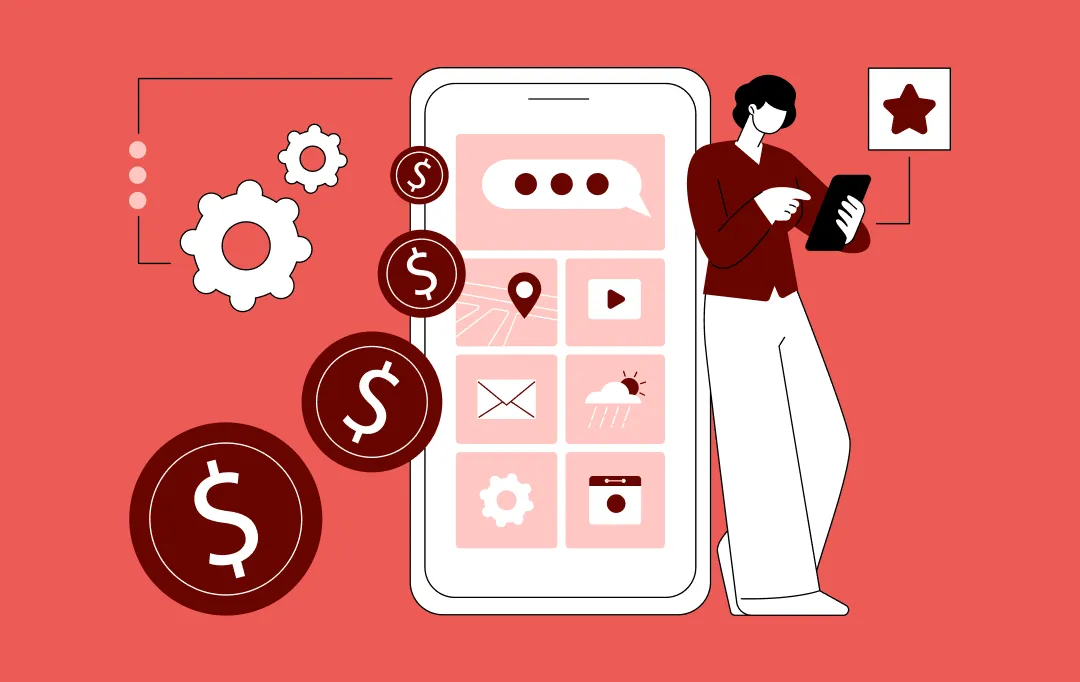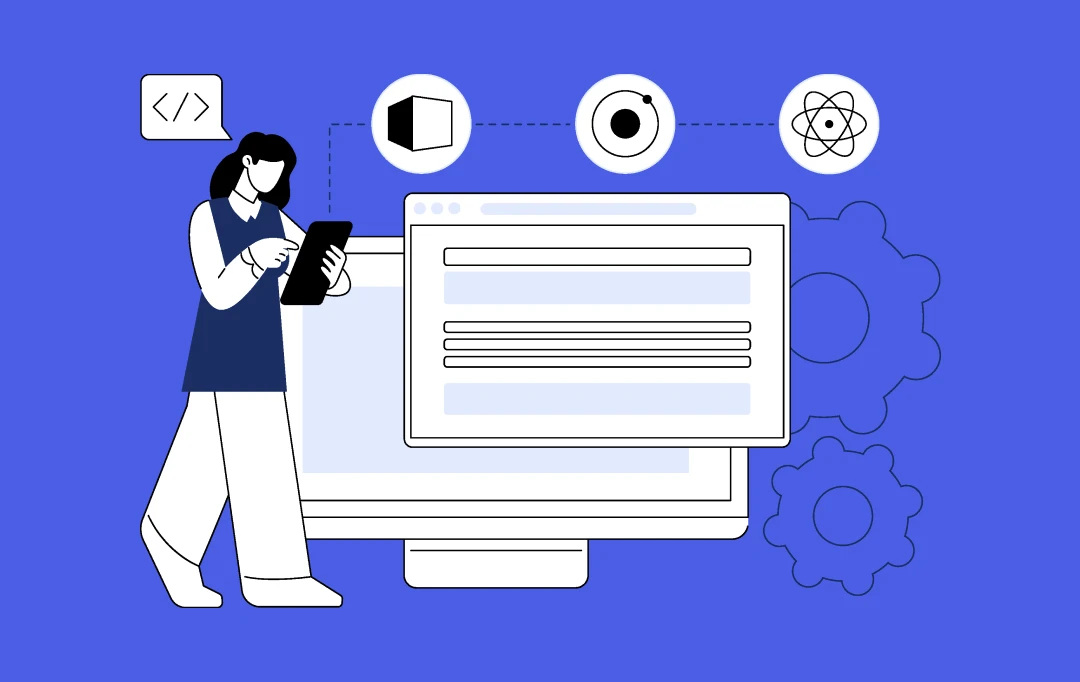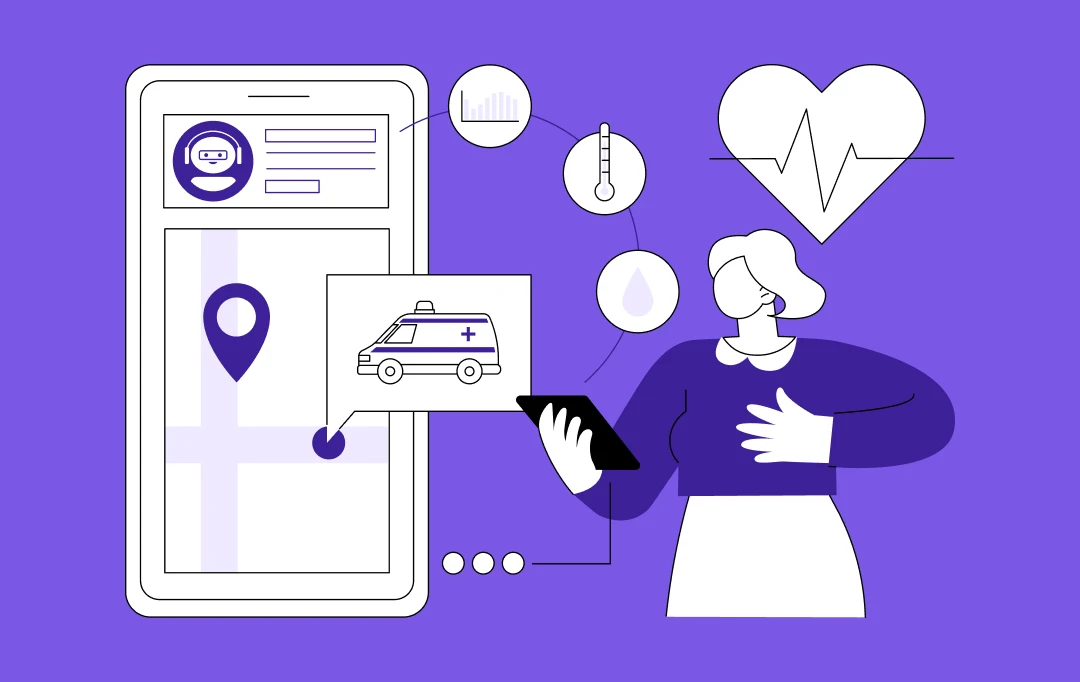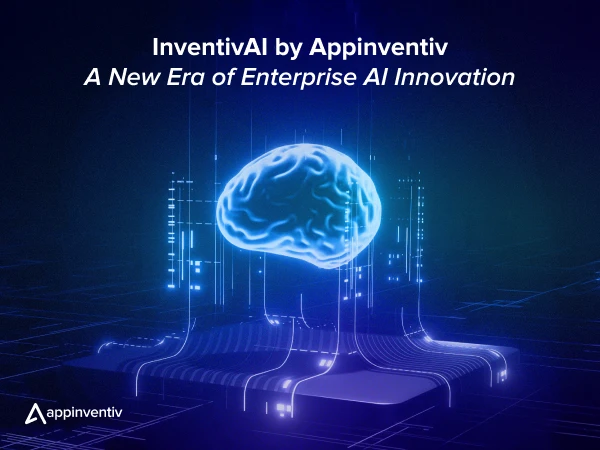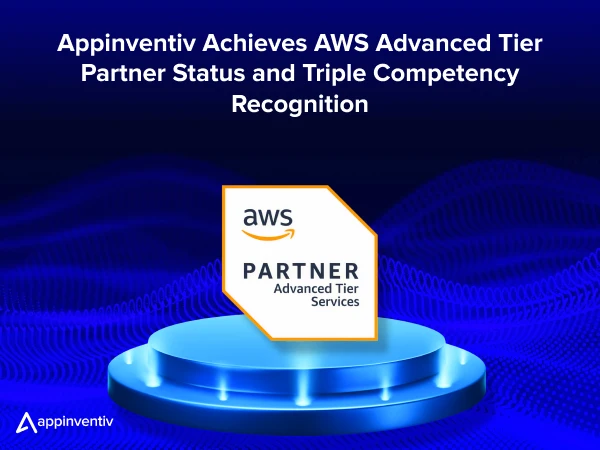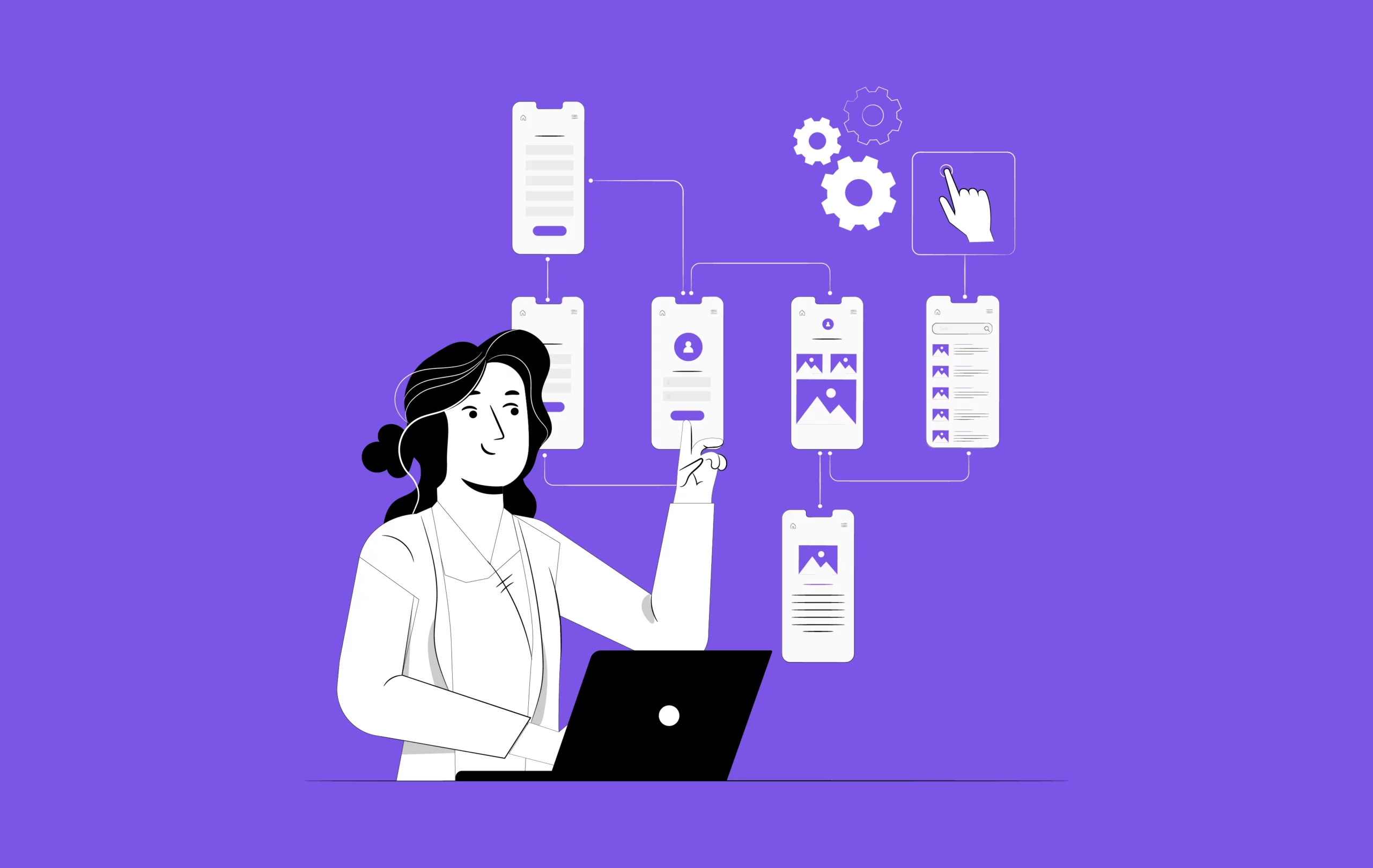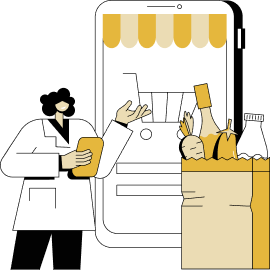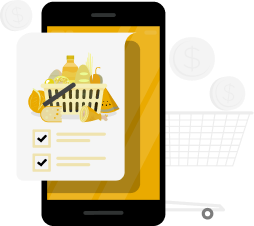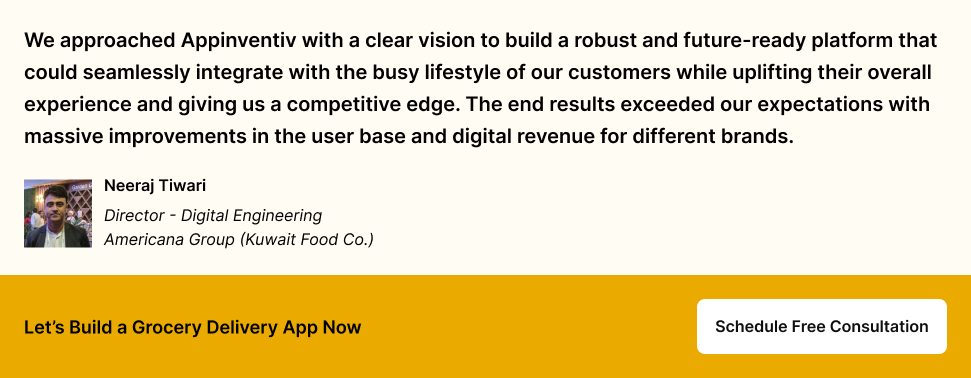- The 2025 Grocery Delivery Explosion with Real World Examples
- Top 3 Business Models That Shape Grocery App Development Costs
- 1. Inventory-Based Model
- 2. Marketplace Model
- 3. Micro Fulfillment Model
- How Do Grocery Apps Work?
- How Much Does It Really Cost to Build a Grocery Delivery App?
- Factors Affecting The Cost of Developing A Grocery Delivery App
- Design Complexity: Way Beyond Looking Pretty
- Backend Architecture: The Foundation That Determines Everything
- Third-Party Integrations: The Sneaky Budget Destroyers
- Security Requirements: Absolutely Non-Negotiable
- Platform Selection: Native vs Cross-Platform Trade-offs
- Technology Integration Complexity
- Features and Functionalities
- The Key Features of a Grocery Delivery App
- List of Features on the Customers’ Side of the Application
- List of Features in the Driver’s Side of the Application
- List of Features in the Admin’s Side of the Application
- List of Features in the Vendor Panel
- Hidden Expenses That Ambush Unsuspecting Entrepreneurs
- Ongoing Maintenance
- Hosting Infrastructure
- Marketing Investment
- Legal and Regulatory Compliance:
- Ways to Optimize On-Demand Grocery Delivery App Development Cost
- MVP Strategy: Validate Before You Invest Big
- Feature Prioritization: Ruthless Focus
- Cross-Platform Development: Maximum Efficiency
- Strategic Outsourcing: Geographic Arbitrage
- Consumer Trends Shaping Grocery Delivery Apps in 2025
- The Grocery Delivery App Development Process
- Revenue Models That Generate Sustainable Profits
- 1. Commission Model
- 2. Advertisement Model
- 3. Subscription Model
- 4. Customer Delivery Fee Structure
- Partner with Appinventiv for Grocery Delivery App Development
- FAQs
Key takeaways:
- Grocery delivery app development cost ranges between $40,000–$400,000; enterprise apps can reach $600,000.
- Consumer trends like AI, AR, and sustainable delivery options are shaping grocery apps’ must-have features.
- Smart budgeting involves building an MVP first and iterating based on user feedback.
- A specialist app development partner like Appinventiv can help you build a secure, scalable, and engaging grocery app.
Online grocery revenue in the US is expected to cross the $45 billion threshold by 2029. In the country, the online grocery customer base counts around 138 million shoppers and is forecast to grow further in the upcoming years (source: Statista).
That’s not just a trend. It’s a market transformation. As consumer expectations shift toward same-day delivery, personalized offers, and AI-powered shopping lists, grocery delivery apps have moved from “nice-to-have” to “indispensable” for both retailers and startups.
But here’s the catch: building such an app isn’t a one-size-fits-all process. A well-planned budget can mean the difference between a market-ready app that scales and a stalled project that drains resources. Miscalculate the development cost, and you risk underfunding critical features or overspending on elements that won’t move the ROI needle.
In this blog, I’ll walk you through the realistic grocery delivery app development cost that ranges from $40,000 to $400,000, with enterprise-grade apps reaching $600,000+. Factors driving these numbers, and how can you make smart trade-offs without compromising on quality? We’ll also look at revenue models, emerging tech trends, and why partnering with the right app development company is a smart choice.
But before that, let’s have a quick look at some major players in the realm and different business models that shape grocery app development costs.
Get a tailored quote for your app development project based on your unique needs and features. Start building your app with a clear cost structure today.
The 2025 Grocery Delivery Explosion with Real World Examples
The data coming out of Statista that online grocery revenue in the US will surpass $455 billion in a couple of years would have blown your mind. This explosive growth is not evolution; it’s a revolution.
Legacy grocery chains are panicking. Kroger threw billions at digital infrastructure because it realized customers weren’t coming back to physical stores. Amazon keeps expanding Fresh and Whole Foods delivery because it can smell the massive profits.
Instacart figured out the secret sauce with its marketplace strategy. They connected over 85,000 stores with customers who wanted convenience. Brilliant move. They solved the impossible last-mile delivery problem that destroyed countless competitors.
Amazon Fresh took a completely different approach. They decided to own everything – inventory, experience, customer relationship. Their 1-2 hour delivery windows aren’t just promises. They’re flexing serious logistical muscle that smaller players can’t match.
However, quick commerce apps like Zepto and Gopuff have pushed the boundaries even further. These apps thrive on ultra-fast delivery — promising delivery windows of 10–15 minutes. They rely on strategically placed micro-fulfillment centers or dark stores that allow them to provide lightning-fast service. Zepto has set the bar high by focusing on densely populated urban areas, where speed and convenience are paramount.
Quick commerce apps like Zepto and Gopuff took grocery delivery a step further with ultra-fast delivery, promising delivery windows of 10–15 minutes. They rely on micro-fulfillment centers or dark stores that allow them to provide lightning-fast service.
Zepto has set the bar high by focusing on densely populated urban areas, where speed and convenience are paramount. Gopuff delivery app went absolutely nuclear with micro-fulfillment centers. Dark stores strategically positioned everywhere, promising delivery in 15-30 minutes. Insanely expensive initially? Absolutely. But once they hit scale, their unit economics became absolutely gorgeous.
Also Read: Cost to Develop a Marketplace App Like Amazon
Top 3 Business Models That Shape Grocery App Development Costs
Your chosen business model will directly influence both your grocery delivery app development cost and the required tech infrastructure. Here are the most common ones:
1. Inventory-Based Model
Inventory models mean owning all products yourself, such as the Amazon Fresh style. You manage your own warehouse or partner with suppliers, handling inventory and fulfillment directly. This demands sophisticated supply chain integration and warehouse management systems that cost serious money.
- Pros: Greater control over product quality and availability.
- Cons: Higher operational overhead.
- Cost Impact: Requires robust inventory management systems and warehouse integration APIs.
2. Marketplace Model
Apps based on marketplace models like Gumtree connect existing retailers with customers. You’ll need incredibly robust multi-vendor management systems that won’t crash during peak demand periods. You act as an aggregator, connecting customers with multiple grocery stores.
- Pros: Faster to scale, lower inventory risk.
- Cons: Reliant on store partners for fulfillment speed and quality.
- Cost Impact: Higher need for merchant dashboards and multi-vendor management features.
3. Micro Fulfillment Model
Micro-fulfillment requires strategically positioned dark stores plus advanced logistics optimization. You maintain a partial inventory while partnering with external vendors for a broader product range. Most expensive upfront investment, but potentially the highest long-term profitability.
- Pros: Balances control with variety.
- Cons: Complex backend architecture to manage both internal and external supply chains.
- Cost Impact: Involves both inventory management and marketplace features.
Your chosen model completely changes grocery mobile app development costs. Pick the wrong foundation and you’ll be rebuilding everything later at triple the original price.
Pro Tip: If you are entering the market with limited capital, start with a marketplace app and expand into inventory control as your user base grows. This staged approach not only reduces your on-demand grocery delivery app development cost but also validates your business model before heavy investment.
How Do Grocery Apps Work?
Online grocery delivery apps allow consumers to get their preferred grocery items delivered to their doorsteps. Such applications are now making grocery shopping quick, easy, and inexpensive. For instance, with grocery delivery apps like Instashop, users no longer need to visit physical stores to pick up their groceries.
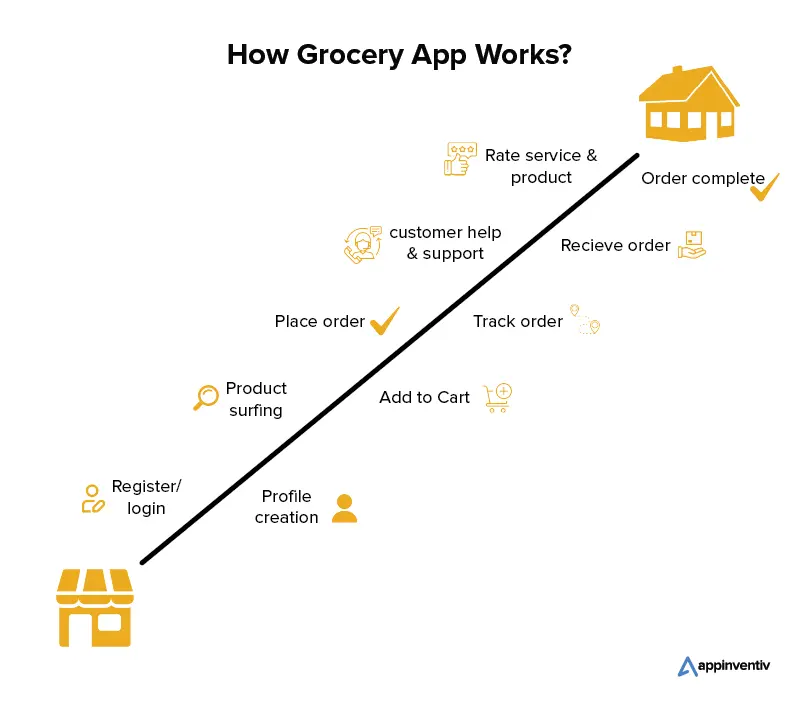
Here’s how grocery delivery works with just a few clicks:
- Users must provide the location and insert their address manually after logging into the app. The app will start showcasing the list of grocery products.
- Users can now choose from a wide range of products, add them to the cart, make payments, and choose the time and date of delivery.
- Consumers can even arrange for a pick up straight from the supermarket. All they need to do is get their order placed and choose a pickup time as per their convenience.
How Much Does It Really Cost to Build a Grocery Delivery App?
Let’s talk honestly. The grocery delivery app development cost isn’t a single fixed figure; It’s a range determined by several critical elements, particularly your app’s features and functionalities. Here’s a realistic cost breakdown based on your project’s complexity level:
| App Type | Core Features | Estimated Cost (USD) | Timeline |
|---|---|---|---|
| Basic MVP | User login Product catalog Basic delivery tracking | $40,000 – $100,000 | 4–6 months |
| Intermediate | Real-time tracking Offers & discounts Push notifications | $100,000 – $200,000 | 6–9 months |
| Advanced | AI recommendations Voice search Multi-store support | $200,000 – $400,000 | 9–12 months |
| Enterprise-grade | AI & AR features Multi-region support IoT integration | $400,000 – $600,000+ | 12–18+ months |
A Quick Formula to Estimate Grocery App Development Costs:
| Developers’ Hourly Rate × Total Development Hours = Total Development Cost |
|---|
For example, a 4,000-hour project at $50/hour will cost $200,000.
Factors Affecting The Cost of Developing A Grocery Delivery App
Though your project’s complex level is a key cost-determining factor, there are several other elements too that drive cost. These aren’t theoretical considerations; they’re the specific factors that separate successful launches from expensive disasters. With that said, let’s examine what components are accountable for increasing or decreasing your grocery delivery app development expenses.
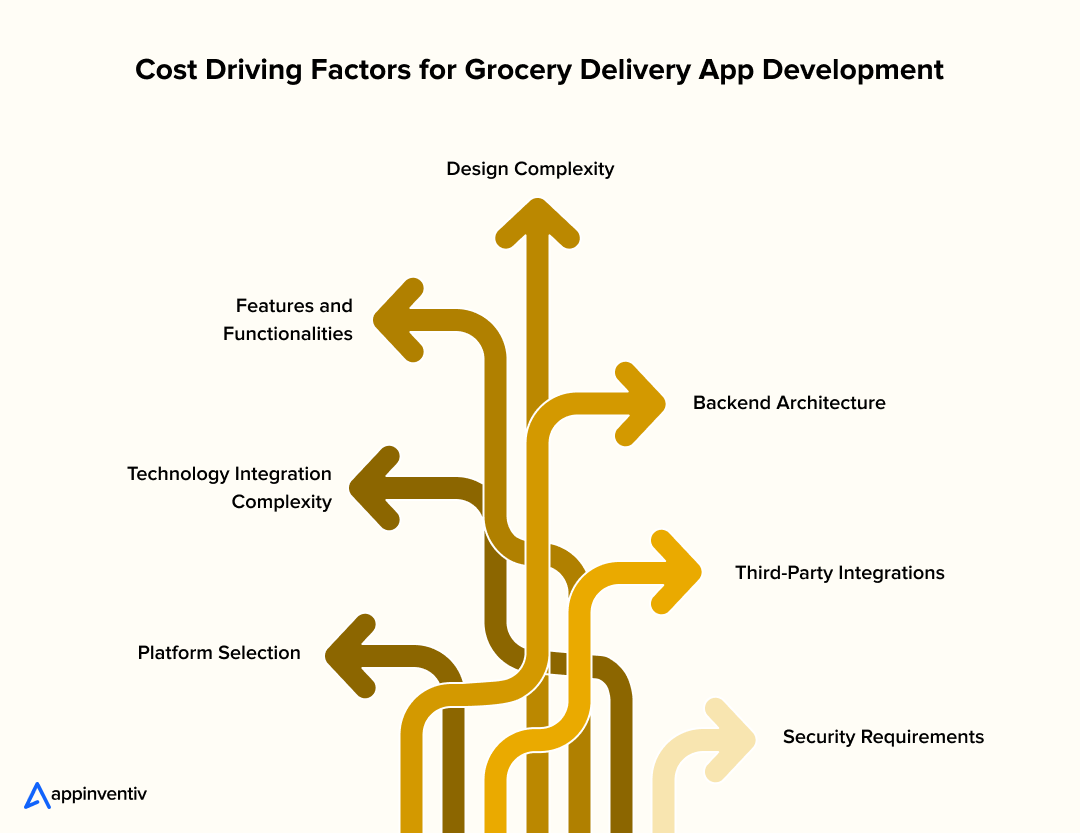
Design Complexity: Way Beyond Looking Pretty
Your app’s design should not be just about aesthetics. It’s about managing complex product inventories while providing an easy-to-use interface that keeps users engaged and satisfied. Confused customers become former customers instantly.
A minimalist interface costs less to design than a fully animated, brand-heavy UI. Remember, the UI/UX design work represents 15-20% of total development costs but determines 80% of first user impressions. Cheap out here and you’ll pay with terrible adoption rates.
| Design Complexity | What You Actually Get | Budget Impact |
|---|---|---|
| Template Basics | Standard layouts with minimal customization | $5,000 – $10,000 |
| Custom Branding | Fully branded interface with custom components | $15,000 – $30,000 |
| Premium Experience | Advanced animations, micro-interactions, full accessibility | $30,000 – $60,000 |
Backend Architecture: The Foundation That Determines Everything
Your backend architecture decides whether your app scales gracefully or crashes spectacularly when success arrives. Grocery platforms demand systems that handle thousands of concurrent users, real-time inventory changes, and complex order management without missing a beat. Backend development is your application’s foundation. Build poorly and everything else collapses.
| Backend Architecture Type | Capabilities | Investment Requirements |
|---|---|---|
| Simple Configuration | Basic CRUD operations, straightforward database | $5,000 – $25,000 |
| Moderate Capabilities | User management, payment processing, basic analytics | $25,000 – $50,000 |
| Complex Infrastructure | Real-time inventory, advanced routing, multi-vendor support | $50,000 – $80,000 |
| Enterprise Architecture | Microservices, unlimited scalability, custom integrations | $80,000 – $100,000 |
Third-Party Integrations: The Sneaky Budget Destroyers
Modern grocery applications absolutely depend on external services. Payment processing, mapping, analytics, communication – every integration adds development time plus ongoing operational expenses.
| Integration Type | Examples | Cost Range |
|---|---|---|
| Basic | Stripe, PayPal, Google Maps. | $5,000 – $10,000 |
| Advanced | ERP, POS, AI analytics tools. | $10,000 – $50,000 |
| Enterprise grade | Custom APIs, legacy systems, compliance platforms | $50,000 – $100,000 |
Security Requirements: Absolutely Non-Negotiable
Grocery applications handle credit card data, personal information, and detailed shopping behaviors. One security breach destroys everything you’ve built instantly. GDPR compliance, PCI DSS requirements, and state-specific privacy regulations add layers of complexity and associated costs. But they’re absolutely mandatory in 2025 and beyond.
| Security Implementation Level | Protection Features | Additional Investment |
|---|---|---|
| Basic Protection | SSL certificates, elementary encryption | $10,000 – $50,000 |
| Standard Security | OAuth implementation, comprehensive data encryption, secure APIs | $50,000 – $100,000 |
| Advanced Protection | Multi-factor authentication, threat detection, compliance frameworks | $100,000 – $150,000 |
Platform Selection: Native vs Cross-Platform Trade-offs
Your platform decision impacts initial development costs and long-term maintenance expenses significantly. In general, if your app is only developed to support a single platform, it won’t be very expensive for you. However, if you want your app to be compatible with two or more platforms, it can cost you a bit more.
Although there are more Android smartphone users worldwide than iPhones, you have to decide which platform to choose. In case you want to target the users of both platforms, then you can go for cross-platform development. Cross-platform frameworks like Flutter or React Native reduce development costs by 30-40%. For most grocery delivery applications, they deliver excellent performance.
| Platform Development Strategy | Key Advantages | Investment Range |
|---|---|---|
| iOS Exclusively | Optimized performance, immediate access to the latest features | $5,000 – $150,000 |
| Android Exclusively | Broader market reach, diverse device support | $25,000 – $150,000 |
| Cross-Platform Framework | Single codebase, accelerated development, cost efficiency | $30,000 – $200,000 |
Technology Integration Complexity
The technology stack you choose fundamentally determines your app’s capabilities, performance, and scalability. Modern grocery delivery apps aren’t just simple ordering systems – they’re complex technological ecosystems requiring multiple integrated components.
Your technology decisions impact everything from real-time inventory management to AI-powered recommendations. Each integration adds development complexity but also provides competitive advantages that can make or break your market position.
| Tech Stack for Grocery Delivery Apps | Capabilities | Development Cost |
|---|---|---|
| Basic Tech Stack | Standard databases, simple APIs, basic real-time features | $5,000 – $15,000 |
| Moderate Integration | Advanced databases, multiple APIs, real-time inventory, push notifications | $20,000 – $35,000 |
| Advanced Tech Stack | Microservices, cloud infrastructure, AI/ML integration, advanced analytics | $40,000 – $70,000 |
| Enterprise Solutions | Multi-cloud architecture, advanced AI, blockchain integration, IoT connectivity | $80,000 – $120,000 |
Also Read: 10 Ways How AI in eCommerce Influences Online Stores
Features and Functionalities
Features and functionalities are the two crucial factors that greatly influence the development cost. In simple words, the more you add features to your on-demand grocery delivery application, the more it will cost you. Although implementing the basic features is vital for your grocery app development process, advanced features (details later) can become an additional development cost for you.
| Feature Category | Features Include | Cost Impact |
|---|---|---|
| Basic Features (MVP) | Product catalog, shopping cart, checkout, payment gateway, basic user authentication. | $5,000 – $12,000 |
| Intermediate Features | Real-time tracking, advanced search filters, ratings & reviews, push notifications. | $10,000 – $20,000 |
| Advanced Features | AI-powered recommendations, loyalty programs, voice search, AR product viewing. | $20,000 – $50,000 |
| Enterprise Features | Multi-region support, personalized shopping experiences, subscription services, real-time stock updates, deep analytics. | $50,000 – $100,000+ |
Since features are the key cost drivers, below we will take a deep dive into the list of some must-have and advanced features for grocery app development.
The Key Features of a Grocery Delivery App
The list of features that have to be considered while looking into on-demand grocery delivery app development is basically divided into four parts. Every set is attending to a specific stakeholder. If you want to know how to build a great grocery app, have a look at the top four panel features to understand the process. Let us look at the feature set one after another.
List of Features on the Customers’ Side of the Application
The customer panel is for the end users to sign up and log in to the app for ordering their groceries. Following is the list of features for the customer panel.

Sign Up and Sign In: The registration and sign-in are the first interaction screens where the customer enters the application. Social media integration is widely used at this stage to make the whole process a whole lot easier.
Profile Management: At this stage, users are given the option to create and update their profiles, which contain information related to their contact details, payment methods, etc.
Product Browsing and Listings: The on-demand grocery app should have a number of products to enlist for the customers to choose from.
Search and Filter: The option should enable the customers to search for something they wish to buy on your application.
Add to Cart and Check-Out: Functionalities like add to cart, wishlist, and checkout should be present in the application to make the whole ordering process easier.
Multiple Payment Options: Your payment gateway integration process should allow customers to pay using multiple payment options – something that makes the whole experience comfortable for them.
e-Wallet Integration: You can also give your customers to keep some money in the in-built wallet to make the check-out process very seamless and quick.
Discount Vouchers and Coupons: Your customers should be given the ease to view and apply the discount code at the time of payment.
Delivery Tracking: Real-time tracking of the order’s location can have a massive impact on user engagement, as customers will always be in the know of their products.
Time Slot Selection for Delivery: Noting that groceries are ordered on the on-demand app mainly by working-class people, we recommend giving them the freedom to choose a time slot at their convenience.
Order History: Customers should be given the facility to check their order purchase history inside the application to make it easy for them to remember whether or not to make a repeat order.
Ratings and Review: Your customers should be allowed to post their experience with a particular store or product on the application for others to see.
Help and Customer Support: You should give your customers a way to reach your team whenever they face any issue. You can add an AI chatbot and virtual assistant to provide great customer support.
Push Notifications: When it comes to mobile app marketing, there is yet to be a mechanism as effective as a push notification. So, your app should also have a well-defined push notification strategy working for it.
List of Features in the Driver’s Side of the Application
The driver’s side or the delivery partner panel contains features that would help the driver or the delivery personnel to manage their task easily and deliver the orders on time.
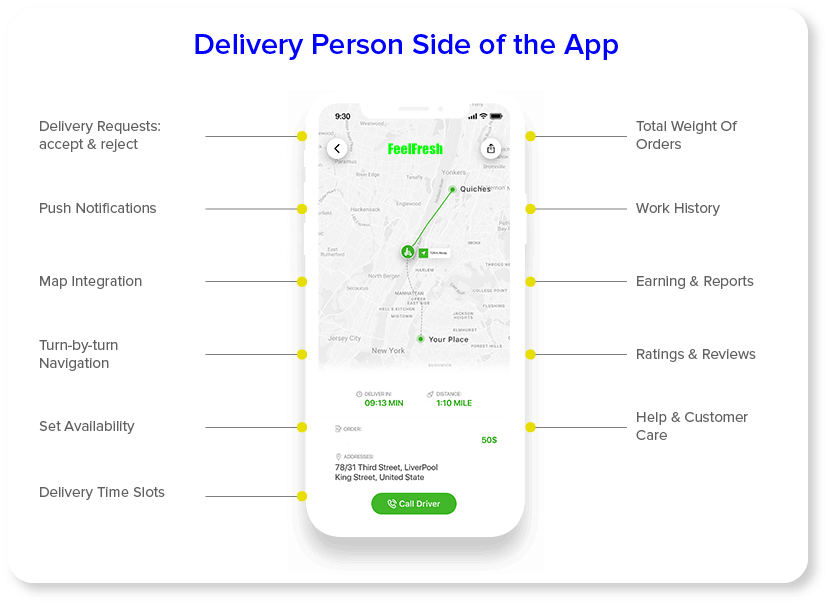
Delivery Requests: The drivers partnered with your application should be given the freedom to accept or reject a particular trip because of any reason.
Push Notifications: All the order delivery information – new and canceled, along with the account debit information, should be given to the drivers through push notifications.
Map Integration: A must-have part of your Grocery app feature for the delivery panel would be the integration of the map to help your drivers locate the customer.
Turn-by-turn Navigation: Inside the map, you should also give the functionality to help drivers with turn-by-turn navigation being spoken out loud.
Set Availability: Drivers should be allowed to set their availability in terms of when they would be present to take the order and deliver it.
Delivery Time Slots: The time slots that the customers select should be shared with the drivers as well to help them know when to pick up the order and deliver it.
Total Weight of Orders: Because the drivers have to carry the order, they should know how much it weighs so that they are able to decide on the vehicle type.
Work History: The details of the trip should be shared with the drivers on their app so that they have a clear idea of their performance at the end of the day.
Earnings and Reports: The invoice and details of their complete earnings should be mentioned clearly inside the application. It will help maintain trust and transparency.
Ratings and Reviews: They should be given the freedom to review and rate a trip as well – after all, accountability rides on both sides.
Help and Customer Care: Just like your customers, your drivers should also be able to easily contact your team when they face an issue.
List of Features in the Admin’s Side of the Application
The admin side features an intuitive panel for the admins to manage all the tasks, including handling complete information of the customer, delivery partner/ driver, and the vendor’s panel.

User Management: Admin of the application will have the ability to add or remove users within the application or change their active status.
Product Management: They should be able to add new products, remove discontinued ones, and even edit their details on the page.
Order Management: Admins will have to be on top of the orders that are being made inside the application. They should be able to manage the order as they prefer (as per policy).
Driver Management: Driver management is a crucial feature that should be present in the admin panel. It should have complete information about the drivers – their contact information, trip details, etc.
Reset Passwords: While password reset is an option that drivers and customers will be working around, the admin should also have the database of passwords with them.
Add, Edit, and Remove Various Elements of Apps: All changes to the application, including user and product information, as well as design modifications, should be easily manageable for the admin.
Payment Management: Every payment detail made inside the application, including refunds, should be made available to the admins with ease.
Campaign Management for Email, SMS, Social Media: Admins should be given the necessary features to plan campaigns around SMS, email, social media, etc., to attract customers to their application.
Run Promotions and Discounts: The admins would be given complete access to run discount and promotional offers across the whole application.
List of Features in the Vendor Panel
A robust vendor panel allows seamless management of orders for customers, assign shipments to the delivery agents, and manage everything under one roof.
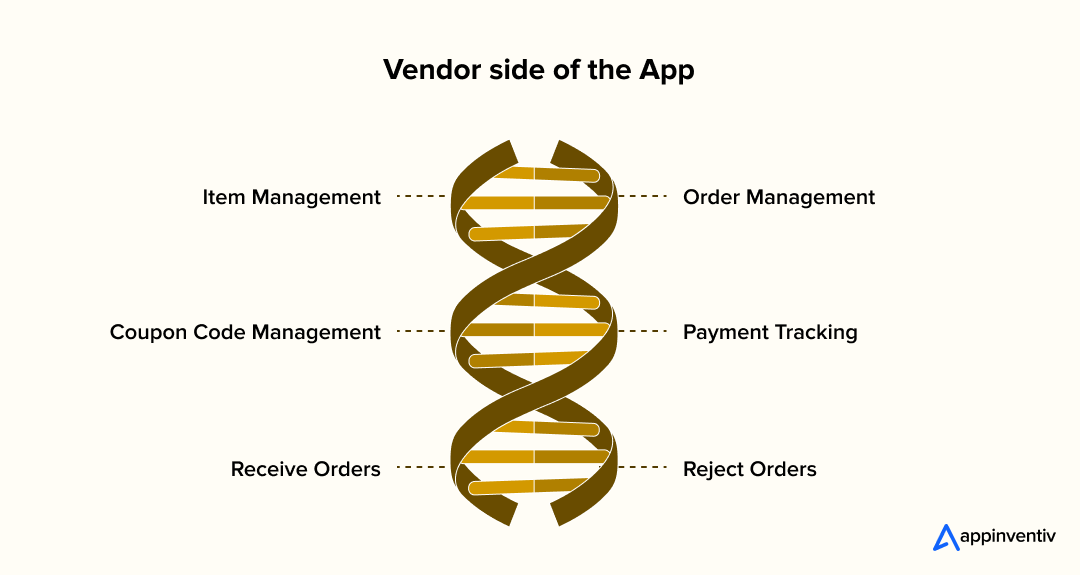
Item Management: The store owners can update or add their prices, product listings, and minimum order quantity, along with the amount, and make the products directly available for ordering.
Order Management: The vendors can now check the status of their order, and the total amount that is collected with each order, and take action accordingly.
Coupon Code Management: The vendors should be able to add new deals, discounts, coupon codes, and offers. Thai helps drive in more sales to the business, thus improving customer retention.
Payment Tracking: The store owners can add their account details and view the pending and successful payment settlements, all in one place.
Receive Orders: This feature allows the vendors to receive orders from customers for different grocery items and accept them for further order processing.
Reject Orders: If a product is out of stock or impossible to deliver to a certain location due to specific reasons, the vendor should be easily able to reject the order.
Hidden Expenses That Ambush Unsuspecting Entrepreneurs
Here’s where things get really expensive. The cost to build a grocery delivery app extends far beyond initial development work. These hidden expenses often represent 25-40% of your total first-year investment.
Ongoing Maintenance
Your application isn’t a completed project. It’s a living system requiring constant attention and updates. Annual maintenance typically runs 15-25% of your original development investment. Built a $100,000 application? Expect $15,000-$25,000 yearly just maintaining basic functionality.
Maintenance covers:
- Critical security patches (cybercriminals never rest)
- Operating system compatibility updates (Apple and Google constantly change requirements)
- Third-party service integration updates
- Bug fixes and performance improvements
- Feature enhancements based on user feedback
Neglect app maintenance costs and your application becomes a security liability with degrading performance. Users abandon broken apps faster than you can imagine.
Hosting Infrastructure
Cloud infrastructure starts reasonably priced but becomes expensive quickly. Successful applications rapidly outgrow basic hosting solutions.
Monthly hosting typically costs $500-$5,000 for growing grocery platforms. Enterprise solutions with high availability and disaster recovery can exceed $10,000 monthly.
The impossible challenge? You can’t accurately predict hosting requirements until you have real users. But you need hosting infrastructure before acquiring users.
Marketing Investment
Building your application is step one. Acquiring customers is step two – and it’s frequently more expensive than development itself.
Customer acquisition costs in grocery delivery average $15-$25 per user. Sounds manageable? Multiply by thousands of users required for business viability.
Most successful grocery applications invest $50,000-$200,000 in initial marketing campaigns, just achieving basic traction in one metropolitan area. That’s in addition to all development expenses.
Legal and Regulatory Compliance:
Regulatory requirements vary by location, but they’re never inexpensive. Business licensing, food handling permits, data privacy compliance – everything adds up quickly.
Initial legal expenses typically range from $5,000 to $25,000. Ongoing compliance costs add another expense layer annually.
Ignore legal requirements and face fines, operational shutdowns, or worse. Ask startups that received GDPR violation penalties about ignoring compliance.
Ways to Optimize On-Demand Grocery Delivery App Development Cost
Want to reduce grocery delivery app development cost without building inferior products? Here’s how successful entrepreneurs optimize their investments.
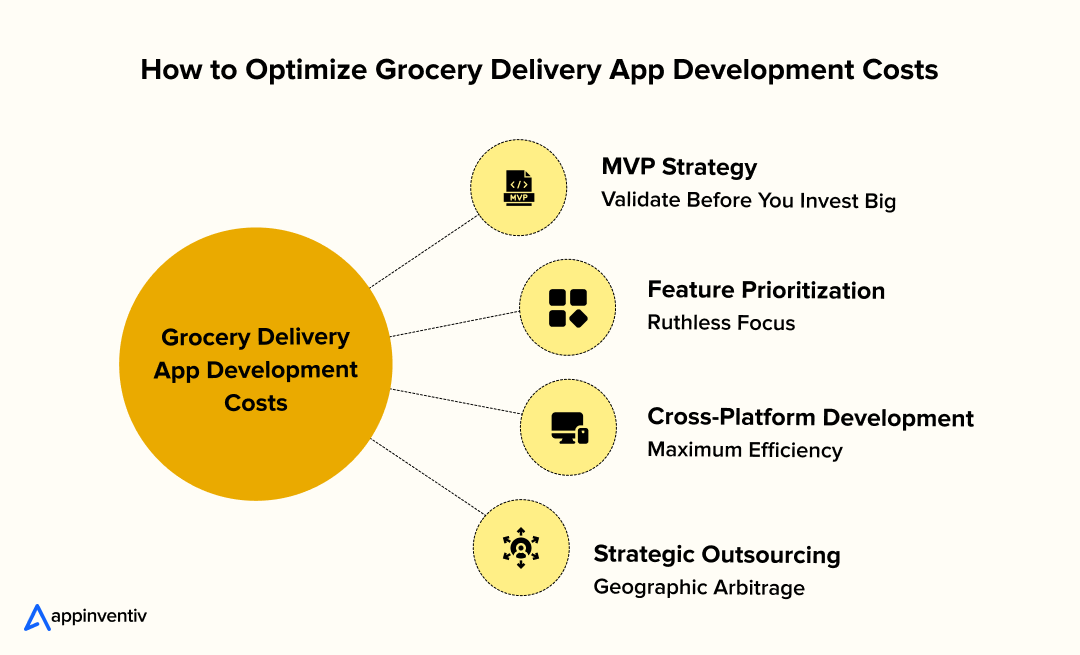
MVP Strategy: Validate Before You Invest Big
The MVP approach lets you test market demand while minimizing financial risk. Instacart didn’t launch with AI recommendations and sophisticated analytics. They started with basic ordering and delivery functionality.
Your MVP should absolutely include:
- Straightforward product catalog and search
- Simple ordering and checkout process
- User registration and profile management
- Basic order tracking and status updates
- Essential payment processing
MVP development costs $40,000-$100,000. That’s your market entry investment. Add sophisticated features after proving demand exists.
Feature Prioritization: Ruthless Focus
Not every feature deserves immediate development attention. Focus exclusively on high-impact, low-complexity functionality initially and grow gradually with advanced, AI-driven functionalities.
Cross-Platform Development: Maximum Efficiency
React Native and Flutter enable simultaneous iOS and Android development. You’ll save 30-40% compared to separate native applications.
Cross-platform advantages:
- Single codebase for ongoing maintenance
- Accelerated development cycles
- Consistent user experience across platforms
- Reduced long-term maintenance costs
Strategic Outsourcing: Geographic Arbitrage
Geographic outsourcing can dramatically reduce grocery delivery app development costs while maintaining development quality. However, the success of your grocery app requires extremely careful partner selection. The secret? Find development teams with proven grocery mobile app development experience, not generic application builders.
- Nearshore Development: 30-50% cost reduction with compatible time zones
- Offshore Development: 50-70% cost reduction with rare communication challenges
- Hybrid Team Structure: Local project management combined with offshore development resources.
Quality outsourcing means completely transparent communication, established development processes, and relevant industry experience.
Consumer Trends Shaping Grocery Delivery Apps in 2025
The grocery delivery space in 2025 is no longer about simply “bringing products to doorsteps.” It’s about anticipating customer needs before they even hit the search bar. That expectation is shaping where investment dollars go in grocery mobile app development. Here are some of the top trends redefining the benefits of developing a grocery delivery app:
- AI-Powered Personalization – Leading apps like Instacart and Walmart+ now use machine learning to build personalized carts. A customer who regularly orders oat milk and fresh berries will see them at the top of their weekly suggestions without searching.
- Voice & Chat Ordering – In busy households, voice commands save minutes per order. Imagine saying, “Add pasta, tomatoes, and basil to my cart” and having the app handle substitutions if a product is out of stock.
- Sustainable Delivery – As climate-conscious shopping grows, features like carbon-offset delivery and minimal packaging options aren’t just PR—they drive loyalty. A Deloitte study in 2024 found that 64% of Gen Zs and 63% of millennials are willing to pay more to buy sustainable products.
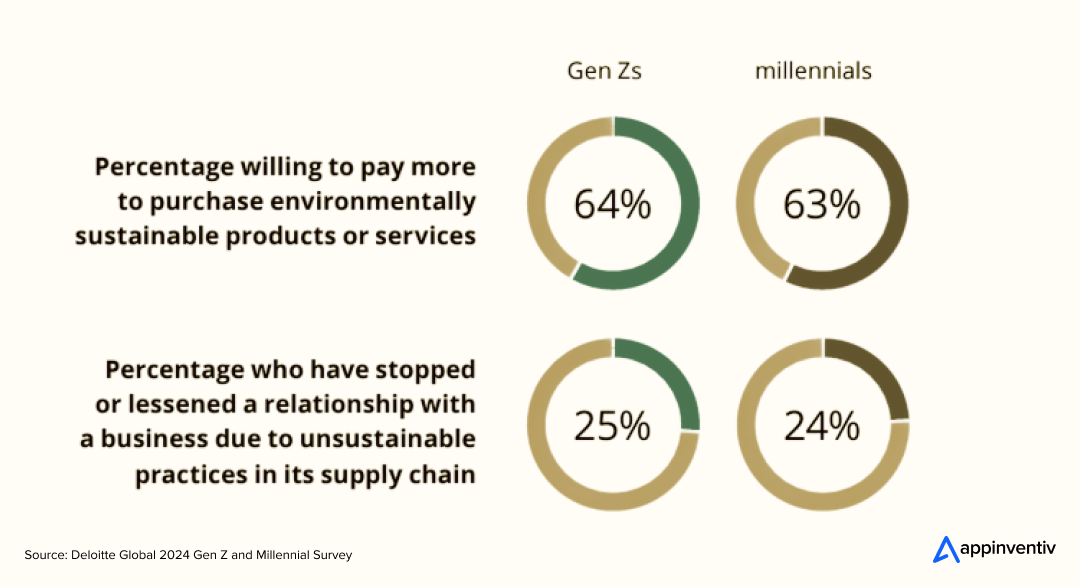
- Augmented Reality (AR) – AR lets customers virtually “walk” store aisles, inspect product packaging, or compare nutrition facts. It’s a feature currently tested by Amazon Fresh and Carrefour.
- Frictionless Payments – Currently, we have a multitude of payment gateways. Go for implementing almost every possible payment gateway that you can to make it easier for your users to choose their preferred mode of payment and process transactions easily. Digital wallets, one-tap checkouts, and BNPL (buy now, pay later), UPI integration, debit/credit card, net banking, etc. reduce cart abandonment rates.
- Real-Time Analytics – Real-time analytics is extremely vital for extracting the processed information out of the data chunks that are stored in the grocery mobile app database. This helps people in governing the grocery stores and admin for checking various related statistics that can make your business a success.
Expert Insight: Adding these innovations may increase your on-demand grocery delivery app development cost, but they also double the benefits of developing a grocery delivery app and future-proof your app.
The Grocery Delivery App Development Process
A successful grocery delivery platform isn’t built in a single sprint. The grocery delivery app development process is iterative, strategic, and involves multiple specialized teams. Here’s a typical grocery delivery app development cost breakdown based on per stage:
| Stage | Activities | Outcome | Cost |
|---|---|---|---|
| Discovery & Planning |
| Clear tech scope aligned with business model. | $2,000–$20,000 |
| UI/UX Design |
| A well-designed interface can reduce churn and enhance user experience. | $5,000–$30,000 |
| Frontend & Backend Development |
| Scalable architecture ensures smoother scaling and avoids costly future migrations. | $15,000–$200,000+ |
| Testing & Deployment |
| Bugs found early prevent expensive post-launch fixes. Deployed at iOS and Android to ensure maximum market reach. | $3,000–$20,000 |
| Post-Launch Maintenance |
| Regular updates and feature improvements lead to higher retention and ASO rankings. | $5,000–$20,000/year |
Let’s discuss how we can turn your vision into reality and optimize the development process for cost efficiency and scalability.
Revenue Models That Generate Sustainable Profits
The business model for an on-demand grocery delivery business involves three models that can help you get good revenue. Here are the top business models or monetization models for an on-demand grocery delivery app:
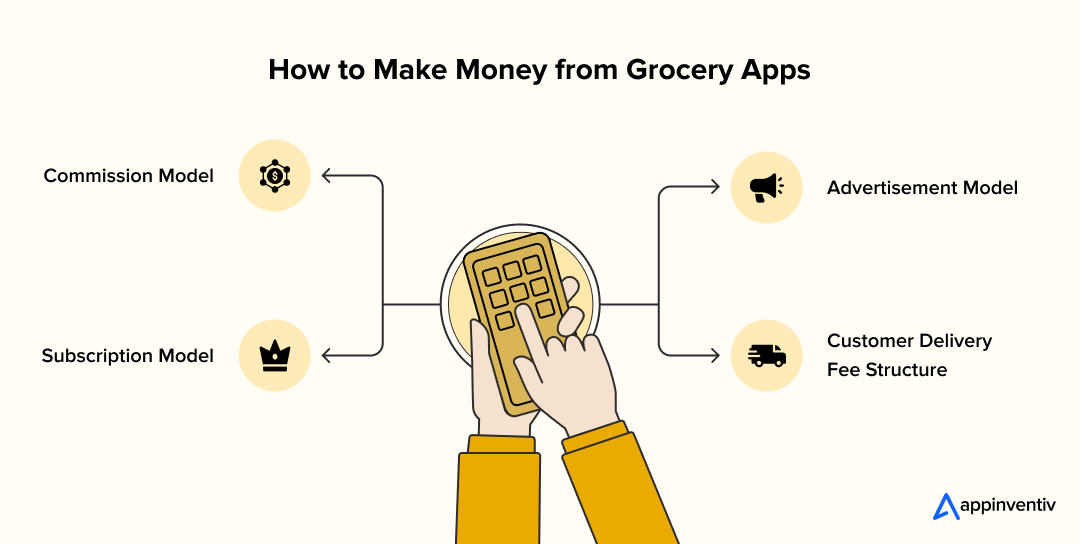
1. Commission Model
This is one of the oldest yet workable models for gaining profit. This type of model is beneficial for both the business owner and the vendors. Let’s understand how the commission model works – For each sale happening on the app, the seller earns their part of the commission, while a very small part of the money is charged from the seller for registering in the app and the buyer for buying a good from the app.
2. Advertisement Model
The advertisement model allows the vendors to place their ads appropriately on the portal. In this monetization model, vendors and sellers run their ad campaigns through the admin. In-app advertising from suppliers and brands generates $0.50-$2.00 per user monthly.
3. Subscription Model
As the name suggests, this kind of business model is based on the subscription method. This includes various offers that depend on the type of subscription plans people buy. In a subscription model, the users purchase the membership for a certain period of time and gain the advantages of the premium services.
Amazon Prime’s massive success proves subscription models work effectively. But you need sufficient order volume to justify subscription costs for customers.
4. Customer Delivery Fee Structure
Charge customers $3-8 per delivery. Higher fees may reduce order frequency but provide predictable revenue per transaction.
The optimal balance? Fees high enough to cover operational costs but low enough to encourage regular ordering behavior.
Also Read: How Do Apps Make Money?
Partner with Appinventiv for Grocery Delivery App Development
Estimating your grocery delivery app development cost isn’t just about adding up hours; it is about aligning your budget with your market goals and customers’ demands. Every dollar spent should serve a clear purpose: improving user experience, scaling operations, driving sales, and increasing revenue.
By working with a trusted tech partner like Appinventiv, you gain more than an app. You get access to a global talent of 1600+ tech experts and a team recognized by Deloitte, Clutch, and Times Business Awards for excellence in mobile app development services.
From UI/UX design to enterprise-level app development, we bring 10+ years of industry experience to deliver next-gen grocery apps on time, within budget, and ahead of market trends.
For instance, our app developers revamped Domino’s UI/UX design, a multinational pizza restaurant app, to help drive more growth and conversion rate. The result? Domino’s witnessed a 23% increase in its user retention.
We also partnered with a leading fast-food company, KFC, under the Americana Group. We helped the brand get seven custom food delivery apps in just 1 year, ensuring a personalized user experience for specific regions and demographics. The application was experiencing poor user engagement. We facilitated multiple order modes and offer the personalization feature in the app for seamless ordering.
The results?
- 22% increase in conversion rate
- 4.5 average rating on the Google Play Store and App Store
- 30,000+ orders filled through the app per day.
- 50%+ of the total orders come through the app now
- 60%+ increase in repeat purchases across channels
- Highest customer lifetime value across all order modes
- Reduced resilience on aggregator apps from 90% to 50%
FAQs
Q. How much does it cost to develop a grocery app?
A. The exact answer to how much online grocery delivery app development costs is a number that we can only arrive at after analyzing your business requirements and expectations from the project.
But if you look at the various cost-driving factors that we have mentioned above, you will get a number in the range of somewhere around $40,000 to $600,000 for all four app complexity levels that we looked into above.
Q. What development timeline should I realistically expect?
A. The development timeline for grocery delivery app development ranges from 4 months to 1 year or more for basic to advanced apps and 12 to 18+ months for enterprise solutions. Timeline includes discovery (3-4 weeks), design (4-8 weeks), development (8-16 weeks), testing (4-8 weeks), and deployment (2-4 weeks).
Complex integrations, custom functionality, and advanced features extend development time significantly.
Q. How should I choose the right development company?
A. To hire the best app development company, you should evaluate potential partners based on relevant grocery delivery experience, technical expertise, portfolio quality, communication processes, and post-launch support capabilities.
Seek companies with proven grocery delivery application development experience and strong client references from similar projects. Generic app developers often lack the specialized knowledge grocery platforms absolutely require.
Q. How can I keep development costs within my budget?
A. Start with MVP development to validate market demand before investing in advanced functionality. Prioritize high-impact features, consider cross-platform development for cost efficiency, and work with experienced teams to avoid costly revisions.
Clear requirements definition and regular communication prevent scope creep that drives budget overruns. Plan for hidden costs like maintenance, hosting, and marketing from project inception.
Q. How does AI improve grocery app shopping experiences?
A. AI enhances grocery applications through personalized product recommendations, demand forecasting for inventory optimization, intelligent search capabilities, and automated customer support systems.
AI features typically add $15,000-$50,000 to development costs but significantly improve user engagement, average order values, and operational efficiency. The investment pays off through improved user retention and higher lifetime values.
Q. Why would I need a grocery delivery app for my business?
A. Grocery delivery apps expand market reach beyond physical locations, provide valuable customer data insights, enable personalized marketing opportunities, and create entirely new revenue streams.
The benefits of developing a grocery delivery app include increased customer convenience, higher order frequency, competitive differentiation, and improved customer lifetime values in an increasingly digital marketplace. Grocery delivery apps also provide direct customer relationships that traditional retail partnerships cannot offer.
Q. What is a white-label on-demand grocery delivery app?
A. A white-label grocery delivery app is a ready-to-deploy application that is pre-loaded with advanced key features that can be rebranded as per the client’s grocery app requirements. These white-label apps are known for saving development time and effort and can be easily customized.
Q. Which is the best grocery delivery application development company?
A. Appinventiv is known for creating the best grocery delivery apps that are multilingual, robust, and fully customized. The scalable grocery delivery application built by our experts automatically takes care of the fulfillment of the order processing. With an intelligent delivery management system, it is easier to manage orders, inventories, and deliveries.
Q. How to create an on-demand grocery delivery app?
A. Here are the basic steps of creating a grocery delivery app:
- First, choose the business model
- Work on four main panels- customer, user, admin, and vendor
- Craft an exceptional website, UI/UX, and app layout
- Choose an ideal tech stack
- Go for testing before launch


- In just 2 mins you will get a response
- Your idea is 100% protected by our Non Disclosure Agreement.

How Much Does It Cost to Build a Car Rental App like Hertz?
Key takeaways: The cost to build a Hertz-like app ranges roughly $40,000–$300,000+. Complexity, automation, and scale matter more than just the number of features. Real costs continue after launch: infra, maintenance, support, and compliance. Smart planning and MVP-first approach help keep budgets under control. Revenue comes from rentals, add-ons, subscriptions, partnerships, and fleet sales. You…

How Much Does It Cost to Build a Banking App like Barclays?
Key takeaways: Barclays sets the bar: Its speed, security, and money management tools show what EU users expect from modern banking apps. Costs vary a lot: A basic, compliant app can start around $40,000 (≈€30,000), while a feature-rich build can reach $400,000+ or more (≈€298,000+). Rules add real work: Meeting PSD2, GDPR, and instant payment…
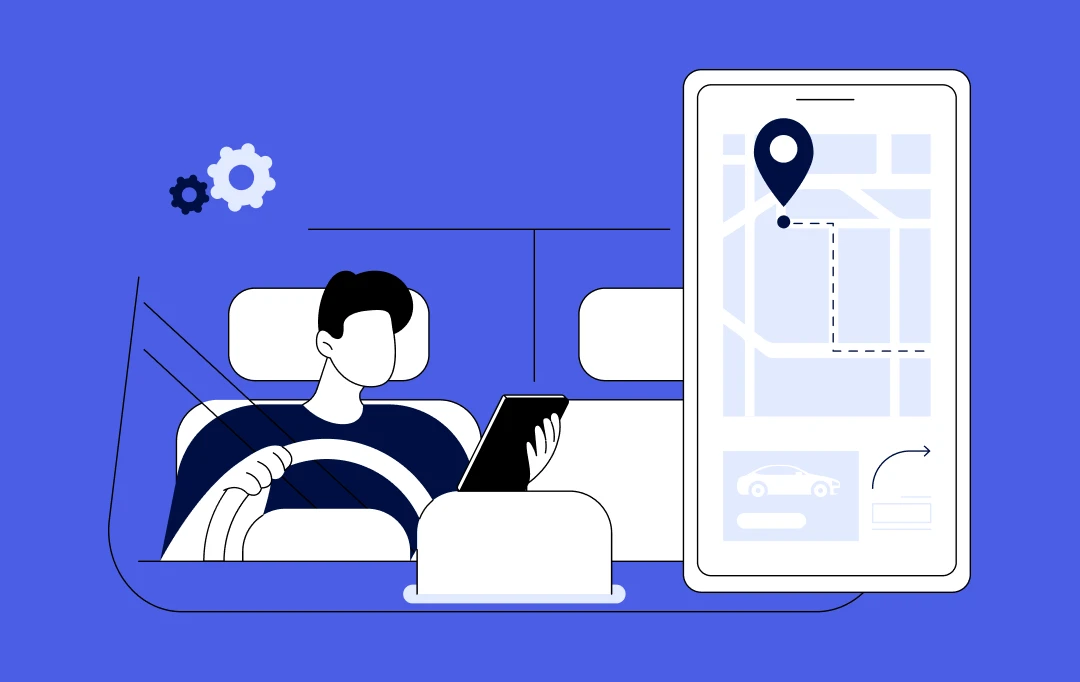
How Much Does It Cost to Build a Route Planning App Like Komoot
Europe doesn’t just love the outdoors- it thrives on it. From the Alps to Amsterdam’s bike lanes, cycling and hiking fuel an industry worth $53.3 billion in 2024, projected to grow at nearly 11% CAGR through 2033, as reported by GrandViewResearch. And leading this charge is Komoot, the route-planning app trusted by 40+ million users.…
